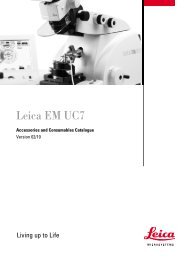Physical Principles of Electron Microscopy: An Introduction to TEM ...
Physical Principles of Electron Microscopy: An Introduction to TEM ...
Physical Principles of Electron Microscopy: An Introduction to TEM ...
You also want an ePaper? Increase the reach of your titles
YUMPU automatically turns print PDFs into web optimized ePapers that Google loves.
The Transmission <strong>Electron</strong> Microscope 65<br />
Table 3-1. Operating parameters <strong>of</strong> four types <strong>of</strong> electron source*<br />
Type <strong>of</strong> source Tungsten<br />
thermionic<br />
LaB 6<br />
thermionic<br />
Schottky<br />
emission<br />
Material W LaB6 ZrO/W W<br />
� (eV) 4.5 2.7 2.8 4.5<br />
Cold field<br />
emission<br />
T (K) 2700 1800 1800 300<br />
E (V/m) low low � 10 8<br />
>10 9<br />
Je (A/m 2 ) � 10 4<br />
� 10 6<br />
� 10 7<br />
� 10 9<br />
� (Am -2 /sr -1 ) � 10 9<br />
� 10 10<br />
� 10 11<br />
� 10 12<br />
ds (�m) � 40 � 10 � 0.02 � 0.01<br />
Vacuum (Pa) < 10 -2<br />
< 10 -4<br />
< 10 -7<br />
� 10 -8<br />
Lifetime (hours) � 100 � 1000 � 10 4<br />
�10 4<br />
�E (eV) 1.5 1.0 0.5 0.3<br />
* � is the work function, T the temperature, E the electric field, Je the current density,<br />
and � the electron-optical brightness at the cathode; ds is the effective (or virtual) source<br />
diameter, and �E is the energy spread <strong>of</strong> the emitted electrons.<br />
Although the available emission current Ie decreases as we proceed from<br />
a tungsten-filament <strong>to</strong> a field-emission source, the effective source diameter<br />
and the emitting area (As = �ds 2 /4) decrease by a greater fac<strong>to</strong>r, resulting in<br />
an increase in the current density Je. More importantly, there is an increase<br />
in a quantity known as the electron-optical brightness � <strong>of</strong> the source,<br />
defined as the current density divided by the solid angle � over which<br />
electrons are emitted:<br />
� = Ie /(As �) = Je /� (3.2)<br />
Note that in three-dimensional geometry, solid angle replaces the concept <strong>of</strong><br />
angle in two-dimensional (Euclidean) geometry. Whereas an angle in radians<br />
is defined by � = s/r, where s is arc length and r is arc radius (see Fig. 3-3a),<br />
solid angle is measured in steradians and defined as � = A/r 2 where A is the<br />
area <strong>of</strong> a section <strong>of</strong> a sphere at distance r (see Fig. 3-3b). Dividing by r 2<br />
makes<br />
� a dimensionless number, just like � .<br />
If electrons were emitted in every possible direction from a point source,<br />
the solid angle <strong>of</strong> emission would be � = A/r 2 = (4�r 2 )/r 2 = 4� steradian. In<br />
practice, � is small and is related in a simple way <strong>to</strong> the half-angle � <strong>of</strong> the<br />
emission cone. Assuming small �, the area <strong>of</strong> the curved end <strong>of</strong> the cone in<br />
Fig.<br />
3-3c approximates <strong>to</strong> that <strong>of</strong> a flat disk <strong>of</strong> radius s, giving:<br />
�� (�s 2 )/r 2 = �� 2<br />
(3.3)



